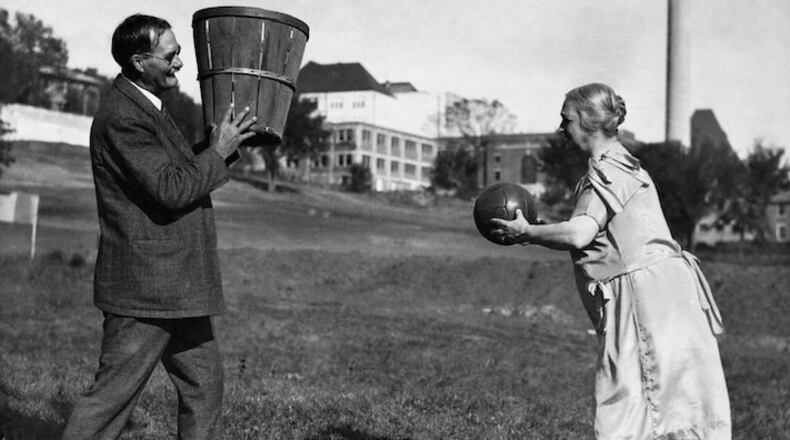James Naismith, basketball’s inventor, arrived in New York City in early 1939 with three items on his agenda.
He gave a speech to basketball writers in which he denounced modern trends in his sport like the zone defense, which he said stalled the game.
“I feel, at times, I’d rather not see basketball,” he said in dismay.
He attended a college basketball doubleheader at Madison Square Garden, where he shook his head at the rough play he saw in a Syracuse victory over Manhattan.
And he appeared on a radio show to recall the birth of basketball, in 1891.
That short interview, on the upbeat program “We the People,” may be the only existing recording of Naismith’s voice. But it surfaced from the WOR-AM archives only as Michael Zogry conducted research for a book about the influence of religion on Naismith’s life.
In the 2 1/2-minute recording, which originally aired Jan. 31, 1939, Naismith reminisced about the first basketball game, played in Massachusetts at what is now Springfield College by students forced inside by the winter weather. The inaugural contest became a melee, with little pretense to civility or resemblance to the game that basketball would become.
“I showed them two peach baskets I’d nailed up at each end of the gym, and I told them the idea was to throw the ball into the opposing team’s peach basket,” Naismith said in an accent influenced by his Canadian upbringing and many years in Kansas. “I blew a whistle, and the first game of basketball began.”
But “the boys began tackling, kicking and punching in the clinches,” Naismith said. “They ended up in a free-for-all in the middle of the gym floor.
The injury toll: several black eyes, one separated shoulder and one player knocked unconscious.
“It certainly was murder,” Naismith told the show’s host, Gabriel Heatter.
Rather than invite further brawling, Naismith changed some of the rules as part of his quest to develop a clean sport.
“The most important one was that there should be no running with the ball,” he said, referring to what became the third of his 13 rules. “That stopped tackling and slugging. We tried out the game with those rules, and we didn’t have one casualty.”
Zogry pointed out that the recording “refutes the idea that he wrote all 13 rules at once; he’s saying that the first game was a laboratory test, and he refined it based on that.”
Jim Naismith, 79, one of James Naismith’s 17 grandchildren, heard the interview last month and chuckled when he heard his grandfather describe his change of course.
“Once you realize what you’ve done isn’t perfect,” Jim Naismith, an engineer, said, “you make modifications.”
It was not unusual for old radio programs to be saved. In the mid-1930s, radio stations and networks began using lacquered discs to record programming, which helped lead to long-term preservation.
“Anything before 1935 would be a rarity,” said Gene DeAnna, the head of the recorded sound division at the Library of Congress, which houses the WOR collection.
DeAnna said that collection — which was donated to the Library of Congress in 1984 by WOR’s owner at the time, RKO General — came in on discs that were transferred first to magnetic tape and more recently to a digital format.
Zogry, an associate professor of religious studies at the University of Kansas and the director of indigenous studies there, had scoured various archives in vain for audio of Naismith and hit dead ends while pursuing references to other sound recordings. But he eventually found his way to the Library of Congress’ WOR catalog and its list of “We the People” recordings.
And last month, when Jim Naismith visited the university in Lawrence, Zogry played him the interview of his grandfather, who died later in 1939 at 78.
“I was so pleased to hear the man’s voice, because I never have,” Jim Naismith said. “The voice was a little higher-pitched than I imagined.”
Naismith, 79, also observed: “I’m older now than he was then. And when you hear someone of that age with such a lively voice, that’s encouraging.”
James Naismith remains a historic figure at Kansas, as the university’s first basketball coach. The two typewritten pages that codified his rules of basketball were donated to the university after being sold at auction for $4.3 million five years ago. The document will soon be on display at a new building on the Lawrence campus.
The interview, which acts as a sort of companion to the rules, helps animate a man known in writing and in photographs, with a middle part to his hair, round glasses and a bushy mustache.
“To hear the voice of someone like this is to give you a sense of the man,” Zogry said. “You hear his sense of humility and his self-effacing personality.”
About the Author
Keep Reading
The Latest
Featured



